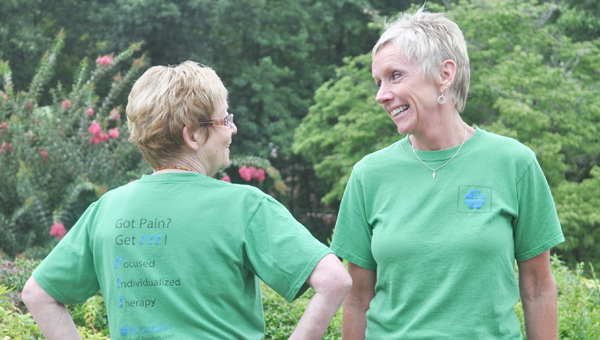St. Luke’s outpatient rehabilitation, prevents injury and restores function
Published 11:19 am Monday, August 27, 2012

The motto for St. Luke’s Outpatient Rehabilitation Center, ‘Get FIT! Focused Individualized Therapy!’ At St. Luke’s Outpatient Rehabilitation Center, patients receive one-on-one treatment with licensed rehab professionals only, and patients will never receive direct patient care from unlicensed staff. Loretta Pack, RN, BSN, and Laura Walker, Physical Therapy Assistant.
Helping people recover from pain, injuries, surgery or illness is the main focus for the rehab professionals at St. Luke’s Hospital. Providing physical therapy, occupational therapy, speech therapy and lymphedema therapy, St. Luke’s rehab staff is equipped with the skills, expertise, technology and encouragement to empower and motivate patients back to work and play.
At a recent meeting of the St. Luke’s Hospital Foundation, members of the Board of Trustees received an educational presentation on the various rehabilitation services offered at St. Luke’s Hospital and St. Luke’s Outpatient Rehabilitation Center.
Scott McDermott, Occupational Therapist and Director of St. Luke’s Outpatient Rehabilitation Center, explained that many people misunderstand the term “occupational therapy” (OT) and think therapists only focus on getting someone back to work.
“Occupational therapy by name alone is very misleading,” McDermott said. “This is really how we spend our time throughout the day and can include dressing, bathing, cooking, child care, playing golf, socializing with friends, work duties, self-care, even sleeping. The main categories of ‘occupation’ include work, self-care, play, and leisure.”
The goal of Occupational Therapy is to help people overcome physical, perceptual and cognitive deficits that can limit their ability to perform these daily tasks and can diminish their ability to function independently and safely. Occupational therapists work to restore function through education, physical and cognitive rehabilitation, adaptive techniques, adaptive equipment and specialized splint fabrication.
McDermott also discussed a comprehensive therapy to help manage lymphedema as well as the Fall Risk Screening and Balance Conditioning Program.
St. Luke’s offers Lymphedema therapy known as Manual Lymph Drainage Therapy (MLD). MLD therapy includes gentle soft tissue mobilization and bandaging techniques that are used to decrease swelling caused by an accumulation of lymphatic fluid in the tissues – primarily the arms or legs.
Physical Therapist and Certified Lymphedema Therapist Sarah Compton, MSRS-PT, MLD-CDT, received advanced training to enable patients to receive this highly specialized treatment closer to home.
With lymphedema, the limbs become so enlarged with lymph fluid that donning clothing is often difficult or impossible and mobility is often impaired. Lymphedema can be a result of missing, impaired, damaged or removed lymph nodes and may occur after breast mastectomies, crush injuries or cancer.
McDermott explained that specialized lymphedema techniques and bandaging techniques are used to decrease edema and that progress towards a permanent garment or sleeve to keep lymphedema minimized is the goal. There is no cure for lymphedema, but patient education, soft-tissue mobilization and bandaging are beneficial to control swelling.





